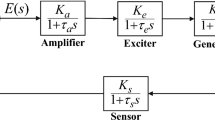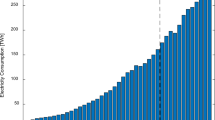Abstract
To improve the short-term power prediction accuracy, a comparative analysis of the PSO and SVM algorithm was carried out. Then, the two were combined and, the penalty factor and kernel function parameters in SVM model were optimized by the improved PSO algorithm. The SVM algorithm with optimized parameters and model were applied to predict and control and form PSO-SVM algorithm. Finally, the short-term power load was modelled and predicted based on PSO-SVM algorithm and it was compared with the conventional SVM algorithm. The results showed that the relative error of the average absolute value of PSO-SVM method was 1.62%, while the relative relative error of the average absolute value of conventional SVM using particle swarm optimization algorithm was 3.52%. It can be seen that the error adopting the new algorithm is reduced by 1.9%. It shows that the precision of the improved power load forecasting model is greatly improved.




Similar content being viewed by others
References
Xiao, Y., Kang, N., Hong, Y., et al.: Misalignment fault diagnosis of DFWT based on IEMD energy entropy and PSO-SVM. Entropy 19(1), 6–21 (2017)
Du, J., Liu, Y., Yu, Y., et al.: A prediction of precipitation data based on support vector machine and particle swarm optimization (PSO-SVM) algorithms. Algorithms 10(2), 57–68 (2017)
Long, Y., Du, Z.J., Wang, W.D., et al.: PSO-SVM-based online locomotion mode identification for rehabilitation robotic exoskeletons. Sensors 16(9), 1408 (2016)
Nieto, P.J.G., García-Gonzalo, E., Sánchez, A.B., et al.: Air quality modeling using the PSO-SVM-based approach, MLP neural network, and M5 model tree in the metropolitan area of Oviedo (Northern Spain). Environ. Model. Assess. 4, 1–19 (2017)
Kapoor, N., Ohri, J.: Fuzzified PSO-SVM controller for motion control of robotic manipulator. Int. J. Ind. Syst. Eng. 24(3), 361 (2016)
Zhou, C., Yin, K., Cao, Y., et al.: Application of time series analysis and PSO–SVM model in predicting the Bazimen landslide in the Three Gorges Reservoir, China. Eng. Geol. 204, 108–120 (2016)
Hayat, M,, Tahir, M.: PSO fuzzy SVM-TMH: identification of transmembrane helix segments using ensemble feature space by incorporated fuzzy support vector machine. Mol. Biosyst. 11(8), 2255–2262 (2015)
Hameed, S.S., Hassan, R., Muhammad, F.F.: Selection and classification of gene expression in autism disorder: use of a combination of statistical filters and a GBPSO-SVM algorithm. PLoS ONE 12(11), e0187371 (2017)
Guo, X., Guo, X., Su, J.: Improved support vector machine short-term power load forecast model based on particle swarm optimization parameters. J. Appl. Sci. 13(9), 1467–1472 (2013)
Selakov, A., Mellon, S., Bekut, D.: Hybrid PSO-SVM method for short-term load forecasting during periods with significant temperature variations in city of Burbank. Appl. Soft Comput. 16(3), 80–88 (2014)
Li, H.Z., Guo, S., Li, C.J., et al.: A hybrid annual power load forecasting model based on generalized regression neural network with fruit fly optimization algorithm. Knowl.-Based Syst. 37(2), 378–387 (2013)
Lee, W.J., Hong, J.: A hybrid dynamic and fuzzy time series model for mid-term power load forecasting. Int. J. Electr. Power Energy Syst. 64, 1057–1062 (2015)
Acknowledgements
The authors acknowledge the National Natural Science Foundation of China (Grant: 111578109), the National Natural Science Foundation of China (Grant: 11111121005).
Author information
Authors and Affiliations
Corresponding author
Rights and permissions
About this article
Cite this article
Tan, X., Yu, F. & Zhao, X. Support vector machine algorithm for artificial intelligence optimization. Cluster Comput 22 (Suppl 6), 15015–15021 (2019). https://doi.org/10.1007/s10586-018-2490-7
Received:
Revised:
Accepted:
Published:
Issue Date:
DOI: https://doi.org/10.1007/s10586-018-2490-7




